
IEMOP manager of Operations Planning and Modeling Edward I. The Independent Market Operator of the Philippines (IEMOP) reported improved peak demand projections just two weeks after the launch. In the Philippines, regulators are already noticing benefits from the launch of a five-minute wholesale electricity spot market in late June 2021. It’s hoped that energy retailers will be able to be more responsive to changing consumer demands and that everyone will benefit from lower wholesale electricity prices. There’s a lot of hype about its potential positive impact, but the proof will be in the pudding. What will 5MS mean for Australian energy retailers - and consumers?įive Minute Settlement (5MS) will start coming into effect from October 1, 2021. They gave members a three-year warning - which was extended slightly in light of Covid-19 market disruption in 2020. In 2017, the Australian Energy Market Commission (AEMC), announced it was time to speed up the settlement period for NEM members to five minutes - not least because technological advances, including the widespread use of smart meters, have made it much easier.
5 MINUTE TIMER PLUS
That pricing anomaly was due to a combination of historical arrangements, plus limitations on metering and data communications.


When the NEM was formed in 1998, the dispatch process by which generators were scheduled operated on a 5-minute basis, even though the settlement process operated on a 30-minute basis. In energy retail, ‘settlement’ refers to the period of time for which usage is settled and billed. How does settlement operate in Australia now? One of the biggest changes to how most Australians keep the lights on is coming in October 2021 - and if retailers aren’t ready now, they’ve got an awful lot of catching up to do. It’s a complex business, made even more complicated by an ever-evolving energy industry and regulatory changes. The NEM, which was formed in 1998, manages a transmission network that carries about 200 terawatts of electricity from a range of sources (predominantly coal, plus small amounts of hydro, gas, winter, solar and battery generators) to large industrial energy users and local electricity distributors across the five regions. Western Australia and the Northern Territory aren’t included in this system for geographical reasons in a country with a land mass of nearly 7.7 million square kilometres, they’re simply too far away. About 10 million customers receive electricity via Australia’s National Electricity Market (NEM), which incorporates more than 40,000km of transmission lines and cables running through five states (Queensland, New South Wales, including the Australian Capital Territory, South Australia, Victoria, and Tasmania). Australia may be the world’s smallest continent, but it has one of the longest interconnected power systems on earth.


 0 kommentar(er)
0 kommentar(er)
